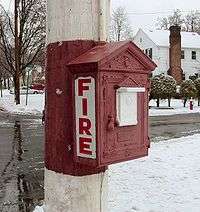Fire alarm call box

Ridgewood, New Jersey
A fire alarm box, fire alarm call box, or fire alarm pull box is a device used for notifying a fire department of a fire. Typically installed on street corners, they were the main means of summoning firefighters before the general availability of telephones.
When the box is activated by turning a knob or pulling a hook, a spring-loaded wheel turns, tapping out a pulsed electrical signal corresponding to the box's number.[1] A receiver at fire headquarters annunciates the pulses through flashing lights or tones, or via a pen recorder, and the box number is matched to a list of box locations. In modern installations a computer receives and translates the pulses; in unmanned installations in small communities, the box number may be sounded out by a horn or bell audible community-wide. Though still in wide use, many communities have removed them, relying instead on the widespread availability of landline and (especially) cellular telephones.[2]
History

The first telegraph fire alarm system was developed by William Francis Channing and Moses G. Farmer in Boston, Massachusetts in 1852.[4] Two years later they applied for a patent for their "Electromagnetic Fire Alarm Telegraph for Cities". In 1855, John Gamewell of South Carolina purchased regional rights to market the fire alarm telegraph, later obtaining the patents and full rights to the system in 1859. John F. Kennard bought the patents from the government after they were seized after the Civil War, returned them to Gamewell, and formed a partnership, Kennard and Co., in 1867 to manufacture the alarm systems. The Gamewell Fire Alarm Telegraph Co. was later formed in 1879. Gamewell systems were installed in 250 cities by 1886 and 500 cities in 1890. By 1910, Gamewell had gained a 95% market share.[5]
Usefulness during communications disruptions
If the power is out, people may not be able to charge batteries in portable phones, and VoIP telephony typically will not work without power. The telegraph alarm boxes,[3] however, are powered from a separate supply and will likely continue to work in the face of outages of both electrical and telephone systems.[4]
False alarm countermeasures
In the later years of their use and proliferation, some fire boxes were designed with special devices and other functions in place in an attempt to curb the nuisance of false alarms. Some of these included an "ear-shattering" wail that would cause discomfort (and possible hearing loss) to someone activating the box, while others would handcuff a detachable part of the device to the person triggering the alarm, so that responding police and fire officials (who possessed the key for release) could more easily identify and contact the individual responsible for the activated alarm.[6][7]
References
- ↑ Fire Alarm Telegraph System - Firefighters Hall & Museum
- ↑ Shifrel, Scott (August 15, 2011). "Federal judge rules against city in bid to take down costly street fire alarm boxes for the deaf". New York Daily News. Archived from the original on 2014-12-15.
- 1 2 Why S.F. still counts on street fire alarm boxes - SFGate
- 1 2 Sweeney, Emily (January 27, 2008). "No cause for alarm". Boston Globe.
- ↑ "Our History". Gamewell-FCI.
- ↑ "Fire Box Foils False Alarms (Oct, 1937)". Retrieved 29 September 2015.
- ↑ "13 Retro Products That Failed To Catch On [pics]". Retrieved 29 September 2015.
External links
- Gamewell-FCI company history
- List of cities with fire box alarm systems
- Fire alarm boxes in New York City
- FDNY fire alarm box locator.
.jpg)